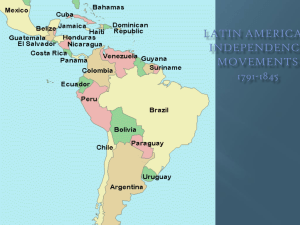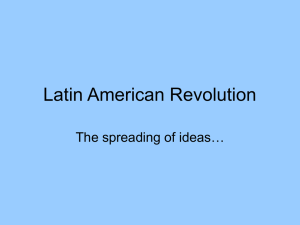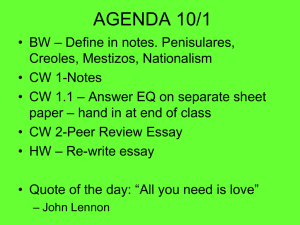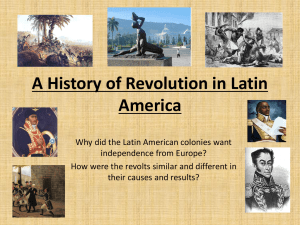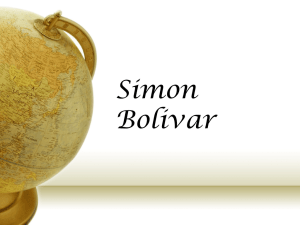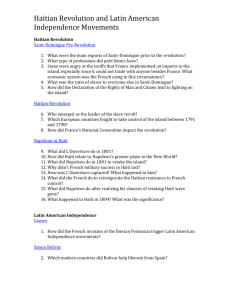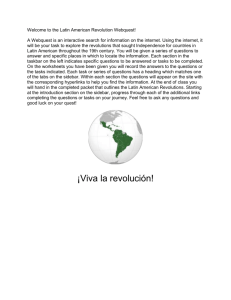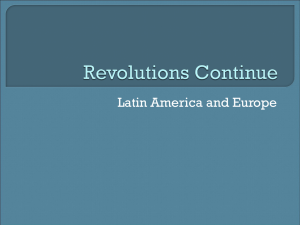Lesson Worksheet - Institute for Student Achievement
advertisement
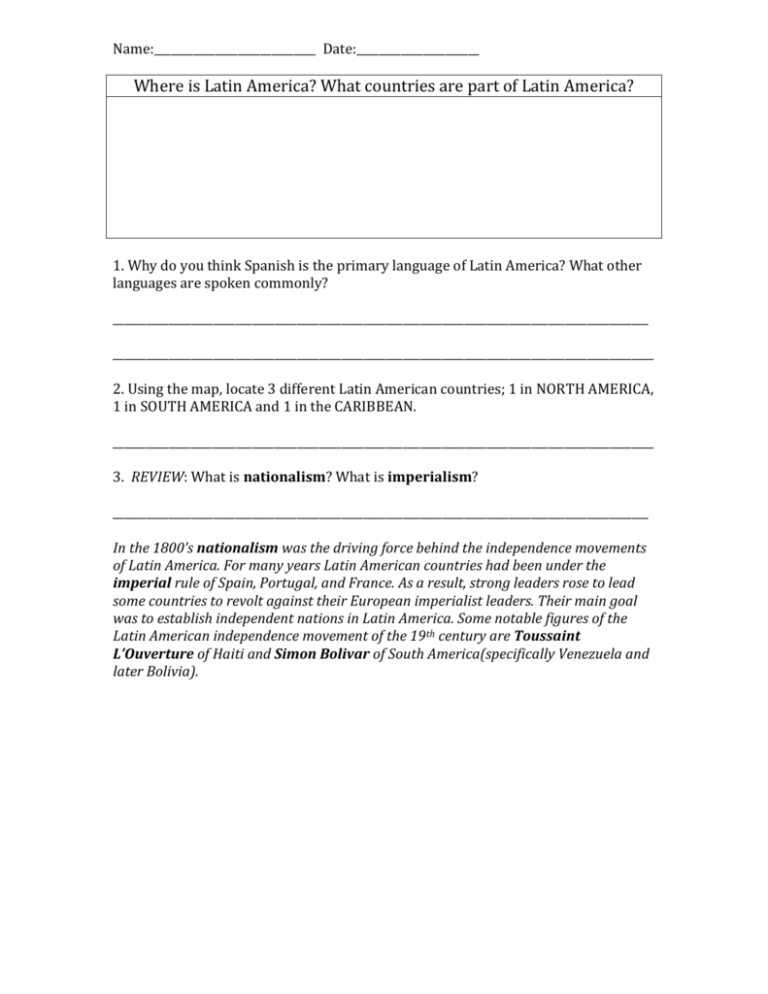
Name:_____________________________ Date:______________________ Where is Latin America? What countries are part of Latin America? 1. Why do you think Spanish is the primary language of Latin America? What other languages are spoken commonly? ________________________________________________________________________________________________ _________________________________________________________________________________________________ 2. Using the map, locate 3 different Latin American countries; 1 in NORTH AMERICA, 1 in SOUTH AMERICA and 1 in the CARIBBEAN. _________________________________________________________________________________________________ 3. REVIEW: What is nationalism? What is imperialism? ________________________________________________________________________________________________ In the 1800’s nationalism was the driving force behind the independence movements of Latin America. For many years Latin American countries had been under the imperial rule of Spain, Portugal, and France. As a result, strong leaders rose to lead some countries to revolt against their European imperialist leaders. Their main goal was to establish independent nations in Latin America. Some notable figures of the Latin American independence movement of the 19th century are Toussaint L’Ouverture of Haiti and Simon Bolivar of South America(specifically Venezuela and later Bolivia). Simon Bolivar BEST KNOWN FOR Simón Bolívar was a Venezuelan military leader who was instrumental, along with José de San Martín, in setting Latin America free from the Spanish Empire. SYNOPSIS Simón Bolívar was a Venezuelan military leader who was instrumental in freeing Latin America from the Spanish Empire. After Napoleon named Bonaparte king of Spain's colonies in the New World. Bolívar joined and eventually led the resistance movement. Under his leadership, the country of Bolivia was created. He united much of South America and many plazas are named after him throughout the world. PROFILE Simón José Antonio de la Santísma Trinidad Bolívar y Palacios was born on July 24, 1783 in Caracas, Venezuela. Bolívar was born into a prosperous family, who took their money from rich gold and copper mines they owned in Venezuela. Young Bolívar moved to Spain in 1799, after the deaths of his parents. In Spain he continued his education, and met his wife Maria Teresa. They returned to Venezuela to visit in 1803, however, María Teresa sickened and died of yellow fever. After his wife’s death, Bolivar went back to Europe where he spent time with Napoleon, the leader of France. Bolívar returned to Venezuela in 1807 and when Napoleon named Joseph Bonaparte King of Spain and its colonies, which included Venezuela, Bolívar joined the resistance movement (the group of people who fought against European Imperialism). Finally, Bolívar returned to Venezuela and began a campaign to take control of Venezuela from the Spanish. He and his followers invaded Venezuela on May 14, 1813; this marked the beginning of his “Compana Admirable” (Admirable Campaign). Bolívar was hailed as El Libertador (The Liberator). 1821 saw the creation of the Gran Colombia, under Bolívar’s leadership. This federation included much of what is now Venezuela, Colombia, Panama, and Ecuador. Further maneuvers saw him named Dictator of Peru in 1824, followed by the creation of Bolivia in 1825. Simón Bolívar had succeeded in uniting much of South America free from Spanish control, but the government was fragile. Despite his desire to create a union of states similar to that which created the United States of America, Bolívar faced opposition. As a temporary measure, Bolívar declared himself dictator in 1828. He resigned this post in 1830 and made plans to sail for exile in Europe. On December 17, 1830, however, Simón Bolívar died in Santa Marta, Colombia, after a battle with tuberculosis. Toussaint-L’Ouverture (1743 –1803) was the leader of the Haitian Revolution. His military genius and political knowledge led to the establishment of the independent black state of Haiti, transforming an entire society of slaves into a free, selfgoverning people. The success of the Haitian Revolution shook the institution of slavery throughout the New World. Toussaint L’Ouverture began his military career as a leader of the 1791 slave rebellion in the French colony of Saint Domingue. Initially allied with the Spaniards of neighboring Santo Domingo, Toussaint switched sides to the French when they abolished slavery. He gradually established control over the whole island and kicked out British invaders. Throughout his years in power, he worked to improve the economy and security of Saint Domingue. He restored the plantation system using free labor, negotiated trade treaties with Britain and the United States and maintained a large and well-disciplined army. In 1801 he created a constitution for the colony, with himself as governor for life. In 1802 he was forced to resign by forces sent by Napoleon Bonaparte from France to restore French authority in the colony. He was deported to France, where he died in 1803. The Haitian Revolution continued under his lieutenant, Jean-Jacques Dessalines, who declared independence in 1804. Questions for Review: Simon Bolivar: 1. What country was Simon Bolivar from? ________________________________________ 2. What country is named after Simon Bolivar?__________________________________ 3. Bolivar’s main objective was to __________________________ all of Latin America from __________________________ imperialism. 4. Was Simon Bolivar ultimately successful or unsuccessful in his mission? Why do you think so? _________________________________________________________________________________________________ _________________________________________________________________________________________________ _________________________________________________________________________________________________ Toussaint L’Ouverture: 1. What country is Toussaint L’Ouverture from? ______________________________ 2. What country was the imperializer of the above country? _______________________ 3. The revolution started by Toussaint L’Ouverture inspired other nations to later abolish _________________________. 4. Who was the leader in France who was an ally and later enemy of Toussaint L’Ouverture? ___________________________. 5. What events were occurring in France just before Toussaint L’Ouverture rose to power in Haiti? __________________________. 6. Was Toussaint L’Ouverture ultimately successful or unsuccessful in his mission? Why do you think so? _________________________________________________________________________________________________ _________________________________________________________________________________________________ _________________________________________________________________________________________________ TEACHER ANSWER KEY Questions for Review: Simon Bolivar: 5. What country was Simon Bolivar from? VENEZUELA 6. What country is named after Simon Bolivar? BOLIVIA 7. Bolivar’s main objective was to FREE all of Latin America from EUROPEAN imperialism. 8. Was Simon Bolivar ultimately successful or unsuccessful in his mission? Why do you think so? _________________________________________________________________________________________________ _________________________________________________________________________________________________ _________________________________________________________________________________________________ Toussaint L’Ouverture: 7. What country is Toussaint L’Ouverture from? HAITI 8. What country was the imperializer of the above country? FRANCE 9. The revolution started by Toussaint L’Ouverture inspired other nations to later abolish SLAVERY 10. Who was the leader in France who was an ally and later enemy of Toussaint L’Ouverture? NAPOLEON BONAPARTE 11. What events were occurring in France just before Toussaint L’Ouverture rose to power in Haiti? THE FRENCH REVOLUTION/REIGN OF TERROR/BEHEADING OF THE MONARCHY (KING LOUIS XVI AND MARIE ANTOINETTE) 12. Was Toussaint L’Ouverture ultimately successful or unsuccessful in his mission? Why do you think so? _________________________________________________________________________________________________ _________________________________________________________________________________________________ _________________________________________________________________________________________________ EXTENSION ACTIVITY: 1. Simon Bolivar and Miguel Hidalgo, leaders of Latin American independence movements, were inspired by successful revolutions in 1) the Untied States and France 2) the Soviet Union and China 3) Cuba and Costa Rica 4) Egypt and Kenya Correct Answer Number: 1 Explanation: The American Revolution (1776) and the French Revolution (1789) both sought to put Enlightenment philosophies into practice, and inspired individuals in Latin American colonies to declare independence from Spain. 2. During the early 1800’s, which was a major influence on the struggle for political independence in Latin America? 1) poor conditions in urban centers in Latin America 2) the American and French Revolutions 3) the desire of the Roman Catholic Church in Latin America to escape European control 4) demands by Latin American workers to own their own factories Correct Answer Number: 2 Explanation: The American Revolution (1776) and the French Revolution (1789) both sought to put Enlightenment philosophies into practice, and inspired individuals in Latin American colonies to declare independence from Spain. 3. One similarity in the leadership of Latin Americas Jose de San Martin, Toussaint l’Ouverture, Bernanrdo O’Higgins, and Pedro I was that each leader 1) opposed United States intervention in Haiti 2) led a struggle to gain freedom for the people of his nation 3) opposed membership of his nation in the League of Nations 4) established an absolute monarchy in his nation Correct Answer Number: 2 Explanation: These men each led independence movements in parts of Latin America. 4. “I will never allow my hands to be idle nor my soul to rest until I have broken the chains laid upon us by Spain.” This statement was most likely made by 1) a Latin American nationalist 2) a Portuguese explorer 3) a Roman Catholic bishop 4) a Spanish conquistador Correct Answer Number: 1 Explanation: Latin American nationalists wanted to end Spanish control of their countries. 5. Which of these situations was the direct result of the other three? 1) nations of Latin America won independence 2) revolutions occurred in North America and France 3) the Napoleonic wars weakened Spain’s power 4) creoles and mestizos became discontented with Spanish rule Correct Answer Number: 1 Explanation: The American Revolution (1776) and the French Revolution (1789) both sought to put Enlightenment philosophies into practice, and inspired individuals in Latin American colonies to declare independence from Spain, which was weakened during the Napoleonic Wars. Also, the strict class system of Spanish controlled Latin America led to discontent among many people. 6. The 19th-century independence movements in Latin America were influenced by 1) Marxist ideology 2) the Aztec wars against Hernando Cortez 3) liberation theology 4) the American and the French Revolutions Correct Answer Number: 4 Explanation: The American Revolution (1776) and the French Revolution (1789) both sought to put Enlightenment philosophies into practice, and inspired individuals in Latin American colonies to declare independence from Spain. 7. In which region of the world did the American Revolution and the French Revolution have the greatest influence during the 1800’s? 1) Southeast Asia 2) Latin America 3) South Asia 4) sub-Saharan Africa Correct Answer Number: 2 Explanation: The American Revolution (1776) and the French Revolution (1789) both sought to put Enlightenment philosophies into practice, and inspired individuals in Latin American colonies to declare independence from Spain.
